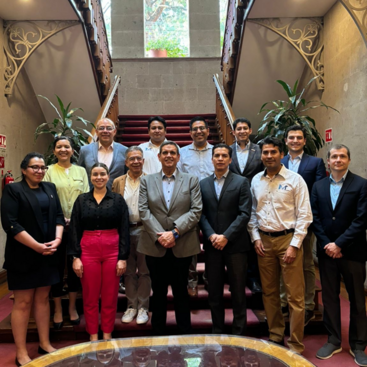CE-CERT Faculty Meet with Medium and Heavy-Duty Zero Emission Vehicle Stakeholders in Mexico

On April 17, 2024, members of the Technical Advisory Committee (TAC) for the project "California-Mexico Border Zero Emissions Vehicle Infrastructure Analysis for Medium-Heavy Duty Vehicles," funded by the University of California Alianza MX, convened at the Casa de California in Mexico City. The meeting was attended by key representatives from various influential organizations, including ANPACT (National Association of Bus, Truck and Tractor Truck Producers), ANTP (National Association of Private Transportation), SICT (Secretariat of Infrastructure, Communications and Transportation), IMT (Mexican Transportation Institute), CANACAR (National Chamber of Freight Transportation), and UC Alianza MX.
The primary focus of the meeting was to address the strategic implementation of zero emissions vehicle (ZEV) infrastructure along the California-Mexico border, specifically targeting medium-heavy duty vehicles (MHDs). This project, led by Dr. Arun Raju and his team at the College of Engineering Center for Environmental Research & Technology (CE-CERT), aims to develop and evaluate scenarios for the deployment of ZEVs in cross-border freight operations.
Key Takeaways from the Meeting:
- Stakeholder Engagement: The meeting emphasized the inclusion of diverse stakeholders in the planning and execution phases. Participants highlighted the importance of engaging industry leaders, government bodies, transport operators, and local communities to ensure the project's success. This collaborative approach is crucial for addressing the unique challenges and opportunities in the California-Mexico border region.
- Infrastructure Development: A major focus of the discussion was the development of necessary infrastructure to support ZEVs. Insights were shared about the current state of infrastructure and the gaps that need to be addressed. Establishing robust charging and refueling stations, especially for MHDs, was highlighted as a critical factor for the successful transition to ZEVs.
- Regulatory and Policy Alignment: Harmonizing regulations between California and Mexico was identified as a key challenge. The group stressed the necessity of aligning policies to facilitate seamless cross-border operations. This includes standardizing vehicle specifications and ensuring mutual support for ZEV deployment.
- Technological Innovations and Challenges: The discussion also covered the technological advancements required for ZEV deployment. Updates were shared on the latest innovations in ZEV technology and the potential hurdles in their implementation. Issues such as battery life, range limitations, and the availability of renewable energy sources were deliberated.
- Economic and Environmental Impacts: The economic benefits and environmental impacts of transitioning to ZEVs were analyzed. While the initial investment is significant, the long-term benefits in terms of reduced emissions and operational costs are substantial. Potential funding sources and financial incentives that could support the transition were also discussed.
- Pilot Programs and Case Studies: The implementation of pilot programs to test the feasibility of ZEVs in real-world scenarios was proposed. These programs would provide valuable data on the performance of ZEVs in cross-border operations and help refine strategies for broader deployment. Lessons and best practices from similar projects in other regions were also considered.
The collaborative effort and shared insights from diverse stakeholders underscore the commitment to achieving a sustainable and efficient transition to zero emissions vehicles in the California-Mexico border region. For more information on the Medium- and Heavy-Duty Vehicles Working Group, please visit Medium- and Heavy-Duty Vehicles Working Group.